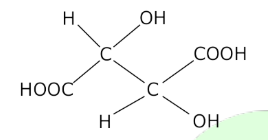Enhanced TDS
Identification & Functionality
- Chemical Family
- Country of Origin
- Ingredient Name
- Tilley Product Number
- CASE Ingredients Functions
- Food Ingredients Functions
- Pharma & Nutraceuticals Functions
- Technologies
- Product Families
- Chemical Structure

Features & Benefits
- Benefit Claims
- Benefit Claims (Health)
- Labeling Claims
- Food Ingredients Features
Applications & Uses
- Markets
- Applications
- Compatible Polymers & Resins
- Compatible Substrates & Surfaces
- Food & Nutrition Applications
- Skin Care Applications
- Applications and Uses
- Acidifier, antioxidizer, emulsifier, flavor exalter and stabilizer.
- Food: Production of tinned food, jam, jelly, confectionery and biscuits in general. Production of soft drinks and table waters. Acidifier in wine-making field. Intermediary for the production of tartaric esters, used as emulsifiers in all the main food industries.
- Pharmaceutical and Cosmetic: Preparation of medicines, effervescent tablets and soluble drugs. Excipient and acidifier in syrups and antibiotics. Production of natural beauty cream for face and body.
- Technical: Retarding agent in the preparation of gypsum, it improves plasticity and resistance of Cements and concretes and it is used in the formulation of waterproof cements and heat insulator. It is also used in textiles (dyeing and printing), tannings, ceramics e Galvano plastics.
Properties
- Physical Form
- Soluble In
- Chemical Properties
Value Units Test Method / Conditions Assay 99.7 - 100.5 % - Specific Rotation (20% w/v) 12 - 12.8 ⁰ - Oxalates Content max. 50 ppm - Chloride Content max. 30 ppm - Sulfates Content max. 150 ppm - Lead Content max. 0.05 ppm - Mercury Content max. 0.05 ppm - Calcium Content max. 25 ppm - Heavy Metals Content (as Pb) max. 2 ppm - Loss on Drying max. 0.2 % - Sulfated Ash max. 0.05 % - Iron Content max. 3 ppm - Arsenic Content max. 0.05 ppm - Cadmium Content max. 0.05 ppm - - Typical Properties
Value Units Test Method / Conditions Molecular formula C₄H₆O₆ - - Molecular Weight 150.09 - - - Physico-Chemical Properties
Value Units Test Method / Conditions Solubility in Water (at 20⁰C) 139 g/100mL - Solubility in Water (at 25⁰C) 147 g/100mL - Solubility in Alcohol (at 25⁰C) 33 g/100mL - Solubility in Ether (at 25⁰C) 0.4 g/100mL - Specific Weight 17,598 g/mL - Loose Bulk Density 0.63 - 1 g/mL - Tapped Bulk Density 0.95 - 1.06 g/mL - Melting Point 168 - 170 ⁰C - pH (solution 0.1N) 2.2 - - - Nutritional Information
Value Units Test Method / Conditions Energy 300 kcal/100g -
Regulatory & Compliance
Technical Details & Test Data
- Standard Particle Sizes
Food & Pharma Grade
Granular Type ENO > 1000 5% max Granular Type 4 > 1000 5% max < 500 10% max Granular Type 3K > 600 5% max < 350 15% max Granular Type 3 > 600 5% max < 300 10% max Granular Type 2 > 400 5% max < 200 10% max Granular Type 2C > 250 20% max < 125 20% max Fine Granular Type 1 > 200 25% max Technical Grade
Powder Type A200 > 200 10% max Powder Type A63 > 63 10% max
Packaging & Availability
- Packaging Information
- Our Natural Tartaric Acid is packed in 15 or 25 Kg bags of paper sewn on the top with an internal polyethylene bag thermowelded.
- Alternatively, it can be packed into big-bag of polypropylene internally coated with polyethylene weighing from 500 to 1500 Kg upon request.
- The bags are palletized and wrapped with shrinkable polyethylene. Each pallet is composed by product of the same batch.
- Every bag or big-bag is labeled with the law indications and the batch identifications. Other types of packaging are available upon request of the customer.
Storage & Handling
- Shelf Life
- 5 years
- Storage and Shelf Life Information
- Our Natural Tartaric Acid is chemically stable, the shelf life is 5 years, but we recommend our customer to operate a good storage rotation, to avoid pallets double-stacking and anyway to reduce the storage time to less than 6 months in order to avoid the caking of the material.
- It must be kept in the original packing, in a dry cool place, avoiding to expose it to very hot or very cold temperatures and to direct sun light.
